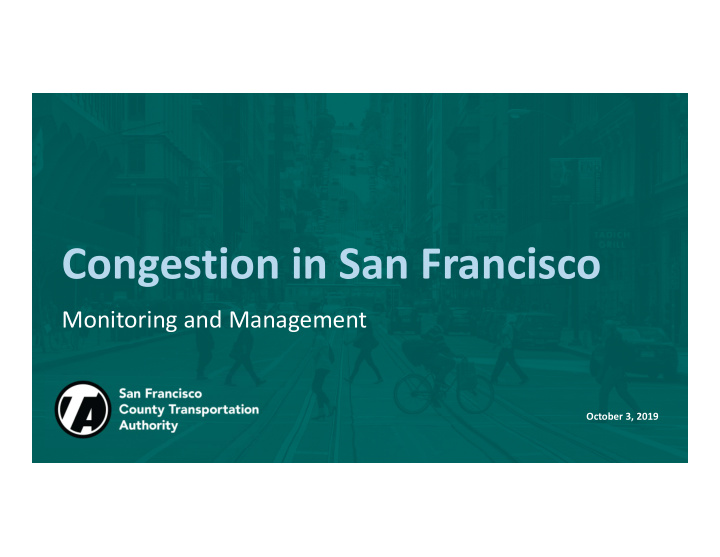



Congestion in San Francisco Monitoring and Management October 3, 2019
Presentation Outline Congestion in San Francisco: now and in the future TNCs and Congestion Impacts on Muni Policy Recommendations 2
We are Growing 1,500,000 SF Population and Employment 1,200,000 1980 – 2050 900,000 600,000 300,000 Population Jobs 0 1980 2015 2050 3
Where Are We Treasure Island Growing? Transit Center District Plan 2015-2050 Change in Central SoMa SF Population and Mission Rock The Hub Employment Density Mission Bay Pier 70 Potrero HOPE SF Based on adopted Potrero Power Station plans, policies, and India Basin entitlements HOPE SF Hunters View Balboa Reservoir Hunters Point Shipyard Parkmerced Schlage Lock HOPE SF Sunnydale Candlestick Point Executive Park 4
Weekday PM peak Traffic is bad speed, 2017 — and it’s getting worse
Average auto speeds 2006 – 2017 Traffic speeds have been declining SFCTA, Congestion Management Program 2017 6
Average transit speeds 2011 – 2017 But transit speeds are relatively stable* *thanks to investments in transit priority streets. SFCTA, Congestion Management Program 2017 7
Auto/transit speed ratio 2011 – 2017 Auto to transit ratio has improved SFCTA, Congestion Management Program 2017 8
Source: SFCTA TNCs & “TNCs Today” 2017 Congestion TNC: Transportation Network Company 9
10 Guiding Principles for Emerging Mobility Equitable Disabled Safety Transit Sustainability Access Access Financial Accountability Labor Collaboration Congestion Impact Adopted by the SFCTA and SFMTA boards.
TNC trips by Time ‐ of Day and Day ‐ of Week AM peak PM peak
CONTEXT Emerging Mobility
Congestion Gets Worse, Auto Speeds Decline Change in Speeds by Time of Day for all roadways in San Francisco Miles per hour SF ‐ CHAMP 13
Transit is More Crowded 250,000 Average Weekday 250,000 11% 11% Passenger Hours 23% 23% 200,000 by Crowding Level 200,000 18% 18% 150,000 150,000 11% 11% 100,000 100,000 50,000 50,000 3% 3% 8% Not crowded 31% 45% 3% 3% 18% 8% 31% 45% 18% Crowded 0 0 2015 2050 2015 2050 2015 2050 2015 2050 2015 2050 20152050 20152050 20152050 20152050 20152050 Transbay service SF ‐ CHAMP 14
Transit is More Crowded 150,000 Average Weekday 19% Not Crowded Passenger Hours Crowded by Crowding Level – 15% Muni 100,000 32% 24% 50,000 Not crowded 0 Crowded 2015 2050 2015 2050 SF ‐ CHAMP 15
Transit is More Crowded 2050 AM Passenger Crowding Level Regional Transit Muni Bus Muni Rail SF ‐ CHAMP 16
Congestion increases operating costs As congestion increases in areas where transit does not have traffic priority measures, transit service becomes slower and more expensive to provide. EXAMPLE: Cost to Provide 10 ‐ Minute Bus Frequency, 6 AM – 12 AM, daily Travel Time Buses Annual Cost (Minutes) Required 30 $3.9 million 45 $5.9 million Travel time and cost 60 $7.9 million increase together 75 $9.9 million Assumes operating cost of $200/hour per vehicle. Actual costs vary by mode.
Muni On ‐ Time Performance
Muni Bunching and Gaps
Muni Forward produces travel time savings • Muni Forward projects generally improve travel time by 10% or more • Over 30 miles implemented to date • Examples: • Church Street: 15% • 5R Fulton Rapid: 9 ‐ 12% • Mission: 13% • 16 th Street: 10% • Potrero: 20% • Two ‐ Way Haight: Over 20% • Sansome: Over 20%
Mission Street Muni Forward • In 2016, SFMTA added transit only lanes, required right turns, stop consolidation, left turn restrictions, and right turn pockets to improve Muni reliability and safety • Travel times reduced by up to 2 minutes but riders perceived a 10 ‐ minute savings • As a result, ridership went up by 4,500 boardings per day in this corridor
Potrero Avenue Muni Forward • In 2018, SFMTA completed improvements on Potrero Avenue to improve Muni reliability • Improvements include red lane, boarding islands, signal priority, stop consolidation, plus pedestrian and bike safety upgrades • These treatments improved travel times by up to 2 minutes • Along with other improvements, this has led to a 38% increase in ridership on the 9 and 9R 22
Delay Hot Spots • Muni Forward covers most but not all delay “hot spots” • Spot improvements can fill in the gaps • We are mapping the 10 slowest Muni segments • Next: develop plan to speed up Muni at each of them, such as turn pockets, queue jumps, signal timing changes, etc.
Top 10 PM Peak hot spots for delay
Congestion Problems for Muni 1. Speed 2. Reliability 3. Crowding 4. Conflicts 25
What’s working? 1. Muni Forward / Red Lanes 2. More and larger vehicles 3. Transportation Sustainability Program including TDM requirements 26
What do we need next? 1. MORE Muni Forward / Red Lanes 2. Close the equity gap 3. Curb management 4. Pricing projects 5. New mobility permitting 6. More funding for transit 27
PRICING STUDY: Downtown Congestion Pricing
Thank you. Any Questions? sfcta.org
For reference only 30
2010 Congestion Pricing Study What scenarios would be feasible and effective? What improvements should be part of the package? What are the potential benefits and impacts? 31 31
PRICING STUDY: US101 to I ‐ 280 Express Lanes M anaged Lanes eval uat ed i n t hi s s t udy M anaged Lanes now M anaged under Lanes now cons t r uct i on under cons t r uct i on
2010 RECOMMENDATION Northeast Cordon Proposed program: $3 toll to cross cordon during peak Discounts & subsidies: Zone resident • Low ‐ income HH • Bridge toll payers • Multimodal investment program 33
2010 RECOMMENDATION Northeast Cordon Benefits: 12% fewer peak period auto trips 21% reduction in vehicle delay 20% – 25% transit speed improvements 16% reduction in Northeast Cordon GHGs 12% reduction in pedestrian collisions Business effects broadly neutral 34
What’s different since 2010 More growth and congestion TNCs (Uber, Lyft) Even more focus on equity Opportunity for incentives 35
New stakeholder conversations NOW: New New equity study Congestion Updated analysis and new Pricing Study recommendations 36
Recommend
More recommend